|
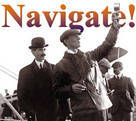
 Up
Up 
 Escalation
Escalation

(You are here.)
 Down
Down




  Need
to Need
to
find your
bearings?
Try
these
navigation aids:
If
this is your first
visit, please stop by:
Something
to share?
Please:



|
|
Available in Française, Español, Português, Deutsch, Россию,
中文,
日本, and others.
 he
Smithsonian did not answer Northcliffe’s accusations. They pointedly
ignored the Albert Medal presentation and continued to promote
Langley’s Aerodrome as the first true airplane. Their contention
seemed on its way to becoming accepted aviation history, a prospect
which rankled Griffith Brewer as much as it did Orville Wright. The
Englishman decided to take another stab at setting the record
straight. he
Smithsonian did not answer Northcliffe’s accusations. They pointedly
ignored the Albert Medal presentation and continued to promote
Langley’s Aerodrome as the first true airplane. Their contention
seemed on its way to becoming accepted aviation history, a prospect
which rankled Griffith Brewer as much as it did Orville Wright. The
Englishman decided to take another stab at setting the record
straight.
On 21 October 1921, Brewer gave a
speech to the Royal Academy of Sciences in London, England titled
“Aviation’s Greatest Controversy.” In it, he charged “the
Hammondsport trials have been inaccurately reported to the
Smithsonian Institution. An official report declaring that the
Langley machine had been flown at Hammondsport has since been issued
by the Smithsonian Institution.” He described the changes that had
been necessary to convert the Aerodrome into an airworthy machine,
and for the first time divided them into alterations that had been
made prior to May-June 1914, and those that had been made afterward.
He also told how the Aerodrome was restored to its original
condition at the Smithsonian, then labeled as the first true
airplane, Brewer said unequivocally “…both the Smithsonian reports
and the inscription on the machine are misleading and untrue. No
attempt was made at Hammondsport to fly the original Langley
machine.” This speech was simultaneously published in the October
edition of the U.S. Air Service Journal, along with rebuttals from
Charles Walcott and Albert Zahm. The November issue carried
rebuttals from Charles Manly and Glenn Curtiss.
Because Brewer
was a patent attorney for the Wrights, some dismissed his attack as
mercenary. However, there was no mercenary effect.
The position of the Smithsonian Institution
at that time represented little hazard to the value of the British
patents; the government had paid its one-time fee. Neither did it
affect the American patents; the NACA/MAA patent pool had both
validated those patents and neutralized their alleged economic
threat. Brewer was simply exposing an untruth and correcting the
historical record as he saw it.
Brewer’s speech
and its rebuttals created a furor. It galvanized Orville, who up to
this time had presumed the Smithsonian was misled by Curtiss and
Zahm. But Walcott’s response to Brewer’s speech had made it clear
that the Smithsonian was partly responsible for the deception, which
hardened Orville in his position. While both sides of the
controversy dug in, Brewer suggested a drastic course of action,
fighting politics with politics – banish the original 1903 Wright
Flyer I, arguably the most precious historic artifact in
aviation, to the Science Museum in Kensington, England’s equivalent
of the Smithsonian. As early as 1920, Sir Henry Lyons, the director
of the Science Museum, had asked to exhibit the Flyer for a short
time while his curators made precise measurements and drawings so
they could build an exact replica of the aircraft. Orville had
promised to supply the drawings himself, but he never seemed to get
around to it. In 1923, Brewer approached both Orville and Lyons with
a proposal to exhibit the Flyer in England permanently.
Since Orville
had begun to exhibit the restored aircraft, several American museums
had offered to give the Flyer a home, but none with the prestige of
the Smithsonian. The Science Museum had the status that Orville
wanted; and although it wasn’t his native land, England had proved
loyal and supportive. He responded to Brewer, “If I were to receive
a proposition from the officers of the Kensington Museum offering to
provide our 1903 machine a permanent home in the Museum, I would
accept the offer, with the understanding, however, that I would have
the right to withdraw it at any time after five years, if some
suitable place for its exhibition in America should present itself.”
Sir Henry Lyons contacted Orville and they began to work out the
details of transporting the plane to England. On 30 April 1925,
Orville announced that he intended to send the Flyer to England
unless the Smithsonian rescinded its position on the Hammondsport
trials – in effect ransoming the Flyer for the truth.
Walcott
responded on 4 May, reasserting the Smithsonian’s position that the
Langley Aerodrome was indeed capable of flight. Even then Orville
made an effort to keep the Flyer in America. He asked Chief Justice
William Howard Taft, who was also the Chancellor of the Smithsonian,
to convene an impartial investigation into the matter. When Taft
declined, Orville had Grover Loening carry a message to the
Smithsonian saying that he would give them the Flyer if, when they
next published their annual report, they would print both sides of
the controversy and display the Flyer in the National Museum with a
label that identified it as the first successful man-carrying
airplane.
Walcott’s
response to this was to ask two fellow members of NACA, Dr. Joseph
Ames (who had helped form the MAA) and Rear Admiral David W. Taylor
to look into the matter and make recommendations. Their report,
submitted 3 June, was a waffle – both sides of this controversy had
some validity, they decided. The Wrights had flown first, but
Langley they likened to Moses. He had led his people to the promised
land of aviation, but either through bad luck or bad design, hadn’t
been able to fly himself. Ames and Taylor’s fence-sitting was best
summed up in the wording they prescribed for a new label on the
Aerodrome exhibit:
“The Original Langley Flying Machine
of 1903 Restored.
“In the opinion of many competent
to judge, this was the first heavier than air craft in the history
of the world capable of sustained free flight under its own power,
carrying a man.
“This aircraft slightly antedated
the machine built be Wilbur and Orville Wright, which on December
17, 1903, was the first in history to accomplish sustained free
flight under its own power, carrying a man.”
Walcott made
the recommended changes to the label, but the interpretive
information displayed with the Aerodrome also included a recounting
of the 1914 Hammondsport trials and stated that the original machine
“would have flown if it had been successfully launched.” It also
said that the Aerodrome’s engine and airframe were the same in the
1914 trials as they were in 1903, and that the wings and controls
had been “reconstructed.” Orville saw the change of labels as
nothing more than smoke, meant to appear conciliatory while the
Smithsonian continued to promote the Aerodrome as the first true
airplane. If he had any doubts that his decision to send the Flyer
abroad was the best course of action, they were resolved by the
reaction of the Washington establishment in 1925.
As Orville was getting the Flyer ready to ship, Charles Walcott died
and Charles Abbot was promoted to Secretary of the Smithsonian.
Abbot had come on board in 1895 to run the Smithsonian’s
Astrophysical Laboratory. He was an ardent admirer of Langley and a
fellow solar scientist. Within weeks of his appointment he dealt
with his first Aerodrome-related crisis as Orville published his
reasons for sending the Flyer abroad, “I believe my course in
sending our Kitty Hawk machine to a foreign museum is the only way
of correcting the history of the flying machine, which by false and
misleading statements has been perverted by the Smithsonian
Institution.” Abbot quickly responded with an offer to change the
label on the Aerodrome – in fact, it was changed to one that simply
read, “Langley Aerodrome, the original Samuel Pierpont Langley
Flying Machine of 1903, Restored.” This was not enough for Orville;
a change of labels did not address the mounds of misinformation that
the Smithsonian put out beginning in 1914.
There were more such crises, and they seemed to
come in quick succession as the twenty-fifth anniversary of the
Kitty Hawk flights came and went. Senator Hiram Bingham and
Representative Lindsay Warren pushed a bill through Congress to fund
a national memorial to the Wright brothers at Kill Devil Hills,
North Carolina in 1927. In 1929, Popular Science magazine
published “The Real Fathers of Flight,” an unauthorized biography of
the Wright brothers in six parts by John R. McMahon. It was expanded
to become a book, “The Wright Brothers: The Fathers of Flight,”
in 1930. Each time the Wright story was told in the media, it
mentioned the exile of Flyer and laid the blame on the Smithsonian.
In an effort to reduce the damage that was
accumulating, Abbot published “The Relations between the Wright
Brothers and the Smithsonian Institution” just before the
twenty-fifth anniversary of the first flight in 1928. It was part
apology, part excuse, and part rationalization. In regard to the
1914 Aerodrome test flights, Abbot said, “In the opinion of some
experts, the tests demonstrated that the Langley machine of 1903
could have flown, and in the opinion of some others, these test did
not demonstrate it. It must ever be a matter of opinion.”
Unfortunately, this wasn’t Orville’s opinion. The two met on 19 April
1929 to discuss their differences and Abbot admitted there were
changes made to the Aerodrome prior to the May-June 1914 flights.
But he refused to publish them or do anything that would damage the
reputation of Charles Walcott or the Smithsonian Institution.
1934, at the
request of Charles Abbot and with the approval of Orville Wright,
Charles Lindbergh waded into the controversy in the hopes that he
could mend fences. Orville told Lindbergh and Abbot precisely what
he needed – an admission that there were changes made to the
Aerodrome prior to the May-June 1914 flights, and that these flights
did not prove it was airworthy in 1903. He produced a list of
changes, carefully winnowed so as not included any changes made
after June 1914, when the Aerodrome test flights entered their
second phase. Abbot suggested publishing a complete history,
including Langley’s work in aeronautics, the history of the
Aerodrome, Zahms’ 1914 report, Orville’s list of changes, Zahm’s
notes on Orville’s list, and all that had happened since 1914.
Orville objected; this was too complex; it obscured the heart of the
controversy. Abbot objected to publishing Orville’s list without
context. Lindbergh eventually gave up.
Lindbergh was
not the first or the last person to attempt to mediate the
Wright/Smithsonian controversy. Throughout his tenure as Secretary,
Abbot received regular correspondence asking why the Smithsonian had
not yet apologized to Orville Wright. The aviation magazine
Contact initiated a drive to petition the Smithsonian to admit
its error. Bills were introduced in Congress to investigate and
resolve the matter. A group calling themselves “Men With Wings”
organized to support the return of the Flyer to America. And
hundreds of concerned Americans, including schoolchildren, wrote the
Smithsonian to complain. This happened so frequently that Abbott
developed a “form letter” to answer these inquiries, enumerating the
things the Smithsonian had done to make amends,
The one thing the Smithsonian
could not do, however, was admit it was wrong. As late as 1941,
Abbot said as much to “Jack” Stearns Gray, an aviatrix who had
barnstormed in a Wright Model B with her husband George Gray
beginning in 1912. Mrs. Gray persisted beyond the form letter,
exchanging opinions with the Secretary several times. Abbot ended
the correspondence on 6 November 1941 writing, “It appears that the
only thing that would satisfy Dr. Wright and his partisans is for
the Institution to say it believes what it does not believe; namely,
that Langley’s plane as of 1903 was by its nature incapable of
flight. I cannot recommend the Institution publish an untruth.”
In Their Own Words
Weird Stuff
|
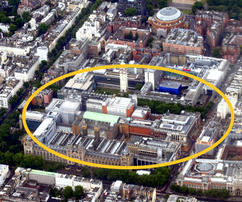
The Science Museum is part of a national museum complex in
Kensington, England that includes the Natural History Museum,
Victoria and Albert Museum, and others.
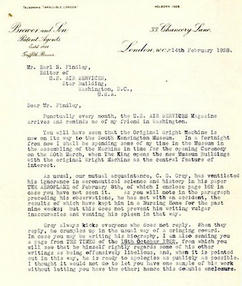
A letter to from Griffith Brewer to Earl Findlay, editor of the US
Air Service Journal, informing him that Brewer would help to
construct the 1903 Wright Flyer when it arrived at the Science
Museum in Kensington. "People from all over the world will learn
that it was not a gimcrack accident which flew to begin with, but a
machine on which all modern aeroplanes are fundamentally based,"
wrote Brewer.
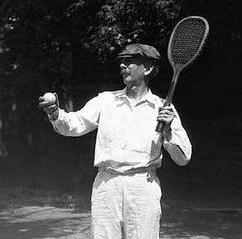
Charles Greeley Abbot playing tennis on the courts behind the
Smithsonian Castle.
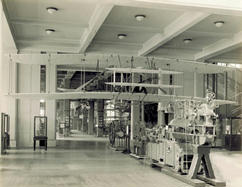
The 1903 Wright Flyer on display in the Kensington Science Museum in
1928.
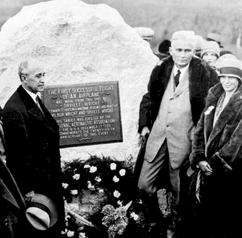
Orville Wright (left) in 1928 at the dedication of the Wright
Brothers Memorial at Kitty Hawk, North Carolina. To the right of the
plaque is Senator Hiram Bingham and Amelia Earhart.
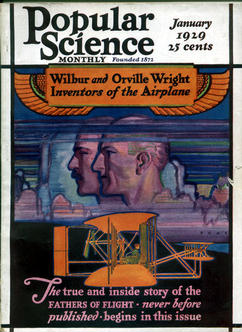
The January 1929 edition of Popular Science began a six-part
biography of the Wright brothers. The author John R. McMahon had
visited the Orville and Katharine Wright in 1915 with another
writer, Earl Findley.
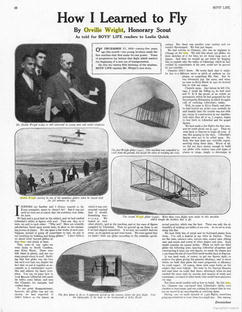
In December 1928, Boys Life Magazine published a special edition on
aviation, encouraging young men to pursue careers in the field. One
of its featured stories was "How I Learned To Fly," by Orville
Wright, Honorary Scout.
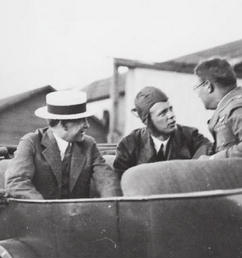
Orville Wright (left) met Charles Lindbergh (center) in 1927 when
Lindbergh landed at Wilbur Wright Field near Dayton, Ohio shortly
after Lindbergh's transatlantic flight. They quickly became friends.
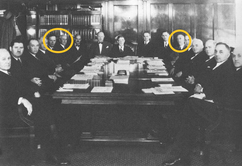
The annual meeting of the National Advisory Council for Aeronautics
(NACA) in 1939. Charles Lindbergh and Orville Wright are seated together on
the left; Charles Abbot is on the right.
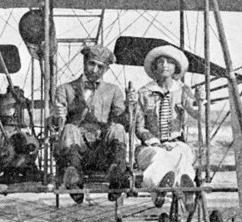
George and Jack Gray barnstorming together in Florida in 1915.
|